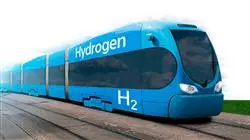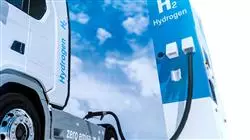University certificate
The world's largest faculty of engineering”
Description
This Postgraduate diploma will lead you to be able to model the behavior of fuel cells in a technical and economical way"

In recent decades, major automobile companies have promoted projects focused on the creation of hydrogen-powered fuel cell vehicles. Likewise, the scientific community is also working on this alternative to traditional combustion, obtaining important results in extending the life of these new electrochemical devices. This advance not only affects this sector, but has also found great business and expansion possibilities in transport vessels, which has given the definitive push in the commitment to this energy.
In a current scenario where sustainability, care for the environment and innovative development prevail, the engineering professional, who specializes in the use of hydrogen, has an excellent opportunity to grow professionally in a booming sector. That is why this academic institution has created this Postgraduate diploma in Hydrogen Equipment Modeling, where you will find the most advanced and current agenda, prepared by experts with extensive experience in the field of management and development of hydrogen-based projects.
In this way, over 6 months, the graduate will learn, through quality multimedia resources, the electrochemistry that governs the reactions, the assembly of the cells to form the stack and its peripherals. In addition, you will be able to delve into the operation of fuel cells and the current state of deployment of hydrogen refueling stations, as well as the procedure for filling vehicles and the design of the different elements of the system to adapt to the different needs of each particular case.
In addition, the Relearning method, based on the reiteration of content, will allow you to progress naturally through the subject matter, even reducing the long hours of study so frequent in other types of education.
A Postgraduate diploma 100% online, which will lead students to advance significantly through a program that can be accessed easily, whenever and wherever you want. All you need is a cell phone, computer or tablet with an Internet connection to view, at any time, the syllabus hosted on the virtual platform. In this way, without the need for attendance or classes with fixed schedules, this program becomes an ideal option for those who seek to combine quality education with their work and/or personal responsibilities.
This program will lead you to investigate the applications of fuel cells in mobility, power generation or thermal generation"
This Postgraduate diploma in Hydrogen Equipment Modeling contains the most complete and up-to-date scientific program on the market. The most important features include:
- Case studies presented by engineering experts
- The graphic, schematic and practical contents of the book provide technical and practical information on those disciplines that are essential for professional practice
- Practical exercises where self-assessment can be used to improve learning
- Its special emphasis on innovative methodologies
- Theoretical lessons, questions to the expert, debate forums on controversial topics, and individual reflection assignments
- Content that is accessible from any fixed or portable device with an Internet connection
With this program you will learn with the most advanced content in the design of the membrane-electrode assembly in PEMFC and in the operation of the fuel cell stack"
The program’s teaching staff includes professionals from the industry who contribute their work experience to this program, as well as renowned specialists from leading societies and prestigious universities.
The multimedia content, developed with the latest educational technology, will provide professionals with situated and contextual learning, i.e., a simulated environment that will provide immersive learning, designed for specialize oneself in real situations.
This program is designed around Problem-Based Learning, whereby the professional must try to solve the different professional practice situations that arise during the academic year For this purpose, the student will be assisted by an innovative interactive video system created by renowned and experienced experts.
Thanks to the Relearning method used by TECH allow you the long hours of study and memorization. Enroll now"

Specialize with this program in modeling the operation of a hydrogen refueling station"
Syllabus
The syllabus of this Postgraduate diploma has been designed to offer in only 6 months, the most comprehensive and intensive knowledge of the academic panorama around Hydrogen Equipment Modeling. This is possible thanks to the syllabus developed by an expert teaching team with extensive professional experience in this field. In this way, students will learn about hydrogen production and electrolysis, the operation of fuel cells and the existing possibilities in the development of refueling stations for hydrogen vehicles. In addition, thanks to the Relearning method, you will advance naturally through the program and reduce the long hours of study and memorization.

An extensive library of multimedia resources is available to you 24 hours a day, 7 days a week"
Module 1. Hydrogen Production and Electrolysis
1.1. Fossil Fuel Production
1.1.1. Hydrocarbon Reforming Production
1.1.2. Generation by Pyrolysis
1.1.3. Coal Gasification
1.2. Production From Biomass
1.2.1. Hydrogen Production by Biomass Gasification
1.2.2. Hydrogen Generation by Biomass Pyrolysis
1.2.3. Aqueous Reforming
1.3. Biological Production
1.3.1. Water Gas Shift Reaction (WGSR)
1.3.2. Dark Fermentation for Biohydrogen Generation
1.3.3. Photofermentation of Organic Compounds for Hydrogen Production
1.4. By-Product of Chemical Processes
1.4.1. Hydrogen as a By-Product of Petrochemical Processes
1.4.2. Hydrogen as a By-Product of Caustic Soda and Chlorine Production
1.4.3. Synthesis Gas as a By-Product Generated in Coke Ovens
1.5. Water Separation
1.5.1. Photolytic Hydrogen Formation
1.5.2. Hydrogen Generation by Photocatalysis
1.5.3. Hydrogen Production by Thermal Separation of Water
1.6. Electrolysis: The Future of Hydrogen Generation
1.6.1. Hydrogen Generation by Electrolysis
1.6.2. Oxidation-Reduction Reaction
1.6.3. Thermodynamics of Electrolysis
1.7. Electrolysis Technologies
1.7.1. Low Temperature Electrolysis: Alkaline and Anionic Technology
1.7.2. Low Temperature Electrolysis: PEM
1.7.3. High Temperature Electrolysis
1.8. Stack: the Heart of an Electrolyzer
1.8.1. Materials and Components in Low-Temperature Electrolysis
1.8.2. Materials and Components in High-Temperature Electrolysis
1.8.3. Stack Assembly in Electrolysis
1.9. Balance of Plant and System
1.9.1. Balance of Plant Components
1.9.2. Balance of Plant Design
1.9.3. Balance of Plant Optimization
1.10. Technical and Economic Characterization of Electrolyzers
1.10.1. Capital and Operating Costs
1.10.2. Technical Characterization of an Electrolyzer Operation
1.10.3. Technical-Economic Modeling
Module 2. Hydrogen Fuel Cells
2.1. PEMFC (Proton-Exchange Membrane Fuel Cell) Fuel Cells
2.1.1. Chemistry Governing PEMFCs
2.1.2. PEMFC Operation
2.1.3. PEMFC Applications
2.2. Membrane-Electrode Assembly in PEMFCs
2.2.1. MEA Materials and Components
2.2.2. PEMFC Catalysts
2.2.3. Circularity in PEMFC
2.3. PEMFC Cell Stacks
2.3.1. Stack Architecture
2.3.2. Assembly
2.3.3. Power Generation
2.4. Balance of Plant and PEMFC Stack System
2.4.1. Balance of Plant Components
2.4.2. Balance of Plant Design
2.4.3. System Optimization
2.5. SOFC (Sodium Oxide Fuel Cells) Fuel Cells
2.5.1. Chemistry Governing SOFCs
2.5.2. SOFCs Operation
2.5.3. Applications
2.6. Other Types of Fuel Cells: Alkaline, Reversible, Direct Methanation, Direct Methanation.
2.6.1. Alkaline Fuel Cells
2.6.2. Reversible Fuel Cells
2.6.3. Direct Methanation Fuel Cells
2.7. Fuel Cell Applications(I) In Mobility, in Electric Power Generation, in Thermal Generation
2.7.1. Fuel Cells in Mobility
2.7.2. Fuel Cells in Power Generation
2.7.3. Fuel Cells in Thermal Generation
2.8. Fuel Cell Applications (II). Technical-Economic Modeling
2.8.1. Technical and Economic Characterization of the PEMFC
2.8.2. Capital and Operating Costs
2.8.3. Technical Characterization of the Operation of a PEMFC
2.8.4. Technical-Economic Modeling
2.9. Dimensioning of PEMFC for Different Applications
2.9.1. Static Modeling
2.9.2. Dynamic Modeling
2.9.3. PEMFC Integration in Vehicles
2.10. Stationary Fuel Cells Grid Integration
2.10.1. Stationary Fuel Cells in Renewable Microgrids
2.10.2. System Modeling
2.10.3. Technical-Economic Study of a Fuel Cell in Stationary Use
Module 3. Hydrogen Vehicle Refueling Stations
3.1. Hydrogen Refueling Corridors and Networks
3.1.1. Hydrogen Vehicle Refueling Networks. Current State
3.1.2. Global Hydrogen Vehicle Refueling Station Deployment Targets
3.1.3. Cross-Border Hydrogen Refueling Corridors
3.2. Hydrogen Plant Types, Modes of Operation and Dispensing Categories
3.2.1. Hydrogen Refueling Station Types
3.2.2. Operating Modes of the Hydrogen Refueling Stations
3.2.3. Dispensing Categories According to Standards
3.3. Design Parameters
3.3.1. Hydrogen Refueling Station. Components
3.3.2. Design Parameters according to Hydrogen Storage Type
3.3.3. Design Parameters according to the Station's Target Use
3.4. Storage and Pressure Levels
3.4.1. Storage of Hydrogen Gas at Hydrogen Refueling Stations
3.4.2. Gas Storage Pressure Levels
3.4.3. Liquid Hydrogen Storage in Hydrogen Refueling Stations
3.5. Compression Stages
3.5.1. Hydrogen Compression. Necessity
3.5.2. Compression Technologies
3.5.3. Optimization
3.6. Dispensing and Precooling
3.6.1. Precooling according to Regulations and Vehicle Type. Necessity
3.6.2. Hydrogen Dispensing Cascade
3.6.3. Thermal Phenomena of Dispensing
3.7. Mechanical Integration
3.7.1. Refueling Stations with On-Site Hydrogen Production
3.7.2. Refueling Stations without Hydrogen Production
3.7.3. Modularization
3.8. Applicable Regulations
3.8.1. Safety Regulations
3.8.2. Hydrogen Quality Standards, Certificates
3.8.3. Civil Regulations
3.9. Preliminary Design of a Hydrogen Plant
3.9.1. Presentation of the Case Study
3.9.2. Development of the Case Study
3.9.3. Resolution
3.10. Cost Analysis
3.10.1. Capital and Operating Costs
3.10.2. Technical Characterization of a Hydrogen Refueling Station Operation
3.10.3. Techno-Economic Modeling

This program will take you delve into the electrochemistry that governs the reactions, the assembly of the cells to form the stack and its peripherals"
Postgraduate Diploma in Hydrogen Equipment Modeling.
Hydrogen equipment modeling is the simulation and design of the various components (such as hydrogen storage tanks, injection systems, and control systems) needed to build hydrogen production and transportation systems. The process begins with gathering information on the needs and requirements of the hydrogen system, which includes the amount of hydrogen that needs to be produced and transported, the pressure and temperature requirements, the types of applications in which the hydrogen will be used, among other factors.
Advanced modeling tools, such as mathematical modeling and computer simulation, are then used to design and simulate the performance of various hydrogen equipment options. Data collected and modeled include reaction kinetics in the production process, heat and mass transfer in storage and transport systems, and process responses to various changes in conditions. From these models, a rigorous evaluation of design options can be made and the best solution for the hydrogen system can be selected in terms of cost, efficiency and safety.
Master hydrogen equipment modeling through this high-level Postgraduate Diploma.
It is important to note that hydrogen equipment modeling is constantly developing as the hydrogen field evolves. Therefore, the models and simulation tools used today will continue to evolve and improve as new technologies and methods of hydrogen production and transport are introduced. At TECH Global University of Technology we have prepared a Master's degree that will pay special attention to the properties of hydrogen, its characteristics as an energy source, and its importance in the transition to a low-carbon economy.







